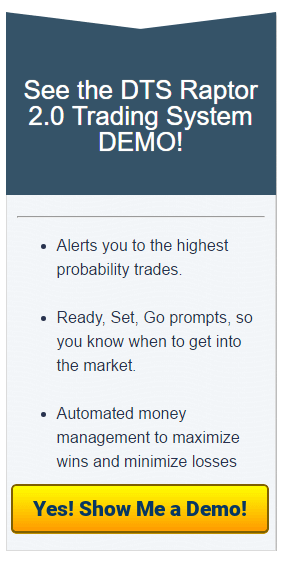Day Trading Tips and Tricks
Trading Options Using a Diversified Trading System
Using Diversified Trading Systems (DTS) for equity options trading can produce strong results. Trading equity options can be used to add “beta” to an existing trade or as “the” trading vehicle.
There are several concepts that are necessary to understand prior to doing options trading based on DTS trading signals.
Definitions for Options Trading

Call option – is an option contract in which the holder (buyer) has the right (but not the obligation) to buy a specified quantity of a security (underlying) at a specified price (strike price) within a fixed period of time (expiration). The writer (seller) of a call option has the obligation to sell the security (underlying) at a specified price (strike price) if the option is exercised. The writer (seller) is paid a premium for taking the associated risk with the obligation.
Put option – is an option contract in which the holder (buyer) has the right (but not the obligation) to sell a specified quantity of a security at a specified price (strike price) within a fixed period of time (expiration). The writer (seller) of a put option has the obligation to buy the security (underlying) at a specified price (strike price). The put option writer (seller) is paid a premium for the associated risk with the obligation.
Strike Price – is defined as the price at which the holder of an option can buy (call option) or sell (put option) a security (underlying) when the option is exercised. The strike price and exercise price are synonymous.
Expiration – all options have a defined limited useful lifespan and every option contract is defined by an expiration month. The expiration date is when an option contract becomes invalid and the right to exercise it no longer exists. Although, every Friday is options expiration not all equities, ETFs, or other underlying securities trade weekly expiration options. A stronger constant is that every third Friday of the month is a more broad options expiration, which would include all equities, ETFs, indexes, futures, and their related derivatives.
Trading Options and Expiration Cycles
In a broad general sense options trading begins in one of three expiration cycles:
- January, April, July, and October
- February, May, August, and November
- March, June, September, and December

Options trading expiration cycles have expanded and contracted in terms of period of time. LEAPS (long-term equity anticipation securities) were introduced and provide expiration dating out 1,2, or 3 years. Quarterly, (or quarterlies), and Weekly (or weeklies) expirations are now common in equity, treasury, forex, and precious metals options.
Exercise – In options trading, to exercise an option is to execute the right of the holder of an option to buy (for call options) or sell (for put options) the underlying security at the strike price.
The difference between American and European style: American style options are exercisable and any time prior to the expiration date. European style options are only exercisable on the expiration date.
Assignment – assignment takes place when the options holder exercises the written option. The options writer is obligated to deliver the terms of the options contract.
The Call options seller (writer) gets assigned to sell the obligated quantity of the underlying security at the strike price to the call option buyer (holder).
The Put options seller (writer) gets assigned to buy the obligated quantity of the underlying security at the strike prices from the put option buyer (holder)
Intrinsic Value – The value of an option if it were to expire immediately with the underlying stock at its current price; the amount by which an option is in the money. For call options, this is the difference between the stock price and the striking price, if that difference is a positive number, or zero otherwise. For Put options, it is the difference between the striking price and the stock price, if that difference is positive, and zero otherwise.
Volatility – A measure of the amount by which an underlying security is expected to fluctuate in a given period of time. Generally measured by the annual standard deviation of the daily price changes in the security.
Implied volatility – A measure of the volatility of the underlying stock, it is determined by using prices currently existing in the market at the time, rather than using historical data on the price changes of the underlying stock.
Historical volatility – Volatility of past price movement of the underlying asset.
At the Money – when the option strike price is the same as the underlying security.
In the Money – when the option strike price is below (in the case of calls) the current price of the underlying or above (in the case of puts) the current price of the underlying.
Out of the Money – when the option strike price is above (in the case of calls) the current price of the underlying or below (in the case of puts) the current price of the underlying.
Bid/Ask Spread – The difference between the prevailing bid and ask price. Generally, option contracts that are more liquid tend to have a tighter Bid/Ask Spread while option contracts that are less liquid and are thinly traded tend to have a wider Bid/Ask Spread.
Options Trading and the Greeks

Beta – a figure that indicates the historical propensity of a stock price to move with the stock market as a whole.
Delta – the amount by which an option’s price will change for a corresponding change in price by the underlying entity. Call options have positive deltas, while put options have negative deltas. Technically, the delta is an instantaneous measure of the option’s price change, so that the delta will be altered for even fractional changes by the underlying entity. Consequently, the terms “up delta” and “down delta” may be applicable. They describe the option’s change after a full 1-point change in price by the underlying security-either up or down. The “up delta” may be larger than the “down delta” for a call option, while the reverse is true for put options.
Gamma – The rate of change of a stock option’s delta for one unit change in the price of the underlying stock.
Rho – the measure of an options sensitivity to changes in interest rates.
Theta – Theta determines the rate of time decay of an option contract’s premium.
Vega – the measure of an options sensitivity to the changes in volatility of the underlying security.
Options Trading Spreads – are the basic building blocks of many options trading strategies. A spread position is entered by buying and selling equal number of options of the same class on the same underlying security but with different strike prices or expiration dates. The three main types of spreads are the horizontal spread, the vertical spread and the diagonal spread. They are grouped by the relationships between the strike price and expiration dates of the options involved.
Vertical Spreads – A vertical spread is a widely used strategy that allows the trader to define risk/reward. Simply put, a vertical spread is done by buying and selling options of the same underlying, the same expiration date but different strike prices. Vertical spreads are considered directional.
Credit Spread – is used when the implied volatility is high
Debit Spread – is used when the implied volatility is low
Ratio Spread – is a strategy that involves buying some number of options and selling a different number of other options of the same underlying market and (usually) the same expiration date, but of a different strike price. Use call options in this strategy if expectations are for the underlying market to move steadily higher, and put options if expectations are for the market to move lower. In the case of call options, the trader will buy some number of options having striking price X and sell a larger number of options having striking price Y, where Y is greater than X. In the case of put options, the trader will buy some number of options having striking price A, and sell a larger number of options having striking price B, where B is less than A.
Calendar Spread – The calendar spread is used when there is a difference in the implied volatilities between two different months’ options. Implement this strategy when the options being bought have a lower implied volatility than the options being sold.
Diagonal Spread – buying and selling (long and short positions) in two options of the same type (call or put) but with different strike prices and expiration dates.
Straddle – buying or selling both a call and put with the same strike price in the same underlying and allows the trader to profit based on a move in either direction.
Strangle – the buying or selling of both a call and put with different strike prices in the same underlying. A strangle is effectively a short iron condor without the wings. It is constructed by purchasing an out-of-the-money put and an out-of-the money call.
Butterfly – a limited risk, non-directional strategy that has a defined profit and loss and would be considered a “volatility play”. Butterfly spreads are utilized when an expected move in volatility would decrease and be lower than the implied volatility.
Iron Condor – an advanced options trading strategy utilizing two vertical spreads – a put spread and a call spread with the same expiration and four different strikes. The word iron in the name of this position indicates that, the position is constructed using both calls and puts. The combination of these two credit spreads makes the long iron condor a credit spread, despite the fact that it is “long.” One of the advantages of an iron condor over a single vertical spread (a put spread or call spread), is that the initial and maintenance margin requirements for the iron condor are often the same as the margin requirements for a single vertical spread, yet the iron condor offers the profit potential of two net credit premiums instead of only one. This can significantly improve the potential rate of return on capital risked when expectations are for the underlying spot price to change significantly.




